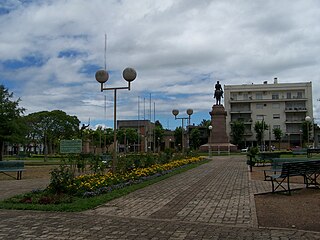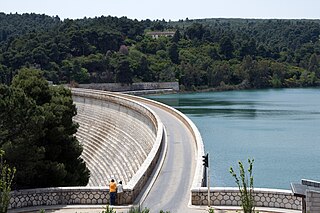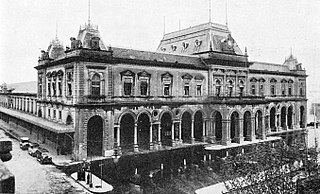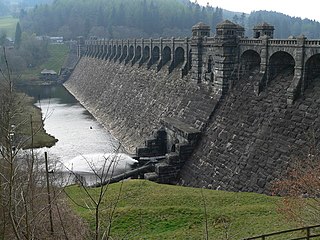
Hoover Dam is a concrete arch-gravity dam in the Black Canyon of the Colorado River, on the border between the U.S. states of Nevada and Arizona. It was constructed between 1931 and 1936 during the Great Depression and was dedicated on September 30, 1935, by President Franklin D. Roosevelt. Its construction was the result of a massive effort involving thousands of workers, and cost over 100 lives. It was referred to as the Hoover Dam after President Herbert Hoover in bills passed by Congress during its construction; it was named the Boulder Dam by the Roosevelt administration. The Hoover Dam name was restored by Congress in 1947.

Uruguay, officially the Oriental Republic of Uruguay or the Republic East of the Uruguay, is a country in South America. It shares borders with Argentina to its west and southwest and Brazil to its north and northeast, while bordering the Río de la Plata to the south and the Atlantic Ocean to the southeast. It is part of the Southern Cone region of South America. Uruguay covers an area of approximately 181,034 square kilometers (69,898 sq mi) and has a population of around 3.4 million, of whom nearly 2 million live in the metropolitan area of its capital and largest city, Montevideo.

Uruguay is a country in the southeastern region of South America, bordering the Atlantic Ocean, between Argentina and Brazil. It is located in the Southern Hemisphere on the Atlantic seaboard of South America between 53 and 58 west longitude and 30 and 35 south latitude. It is bordered to the west by Argentina, on the north and northeast by Brazil, and on the southeast by the Atlantic Ocean, which makes up Uruguay's coast.

Montevideo is the capital and largest city of Uruguay. According to the 2011 census, the city proper has a population of 1,319,108 in an area of 201 square kilometers (78 sq mi). Montevideo is situated on the southern coast of the country, on the northeastern bank of the Río de la Plata.

Grand Coulee Dam is a concrete gravity dam on the Columbia River in the U.S. state of Washington, built to produce hydroelectric power and provide irrigation water. Constructed between 1933 and 1942, Grand Coulee originally had two powerhouses. The third powerhouse ("Nat"), completed in 1974 to increase energy production, makes Grand Coulee the largest power station in the United States by nameplate capacity at 6,809 MW.

The St. Francis Dam was a concrete gravity dam located in San Francisquito Canyon in northern Los Angeles County, California that was built between 1924 and 1926 to serve the city of Los Angeles's growing water needs. It failed catastrophically in 1928 due to a defective soil foundation and design flaws, unleashing a flood that claimed the lives of at least 431 people. The collapse of the dam is considered to have been one of the worst American civil engineering disasters of the 20th century, and remains the 3rd-greatest loss of life in California's history, exceeded only by the 1906 San Francisco earthquake and fire and the Great Flood of 1862.

The Los Angeles Aqueduct system, comprising the Los Angeles Aqueduct and the Second Los Angeles Aqueduct, is a water conveyance system, built and operated by the Los Angeles Department of Water and Power. The Owens Valley aqueduct was designed and built by the city's water department, at the time named The Bureau of Los Angeles Aqueduct, under the supervision of the department's Chief Engineer William Mulholland. The system delivers water from the Owens River in the eastern Sierra Nevada mountains to Los Angeles.

Salto is the capital city of the Salto Department in northwestern Uruguay. As of the 2011 census it had a population of 104,028 and is the third most populated city in Uruguay, after Montevideo and Ciudad de la Costa.

The Bull Run River is a 21.9-mile (35.2 km) tributary of the Sandy River in the U.S. state of Oregon. Beginning at the lower end of Bull Run Lake in the Cascade Range, it flows generally west through the Bull Run Watershed Management Unit (BRWMU), a restricted area meant to protect the river and its tributaries from contamination. The river, impounded by two artificial storage reservoirs as well as the lake, is the primary source of drinking water for the city of Portland, Oregon.

A combination of aqueducts, reservoirs, and tunnels supplies fresh water to New York City. With three major water systems stretching up to 125 miles (201 km) away from the city, its water supply system is one of the most extensive municipal water systems in the world.

Walka Water Works is a heritage-listed 19th-century pumping station at 55 Scobies Lane, Oakhampton Heights, City of Maitland, New South Wales, Australia. Originally built in 1887 to supply water to Newcastle and the lower Hunter Valley, it has since been restored and preserved and is part of Maitland City Council's Walka Recreation and Wildlife Reserve. It was added to the New South Wales State Heritage Register on 2 April 1999.
The Bersimis-1 generating station is a dam and a hydroelectric power station built by Hydro-Québec in conjunction with Perini, Atlas and Cartier construction companies on the Betsiamites River, in Lac-au-Brochet, 85 km (53 mi) north of the town of Forestville, Quebec. Construction started in 1953 and the power station was commissioned in 1956 with an initial nameplate capacity of 912 megawatts.

The Marathon Dam is a gravity dam on the Charadros River, near its junction with the Varnavas Stream, 8 km (5 mi) west of Marathon and 45 km (28 mi) northeast of Athens in Greece. The dam created Lake Marathon for the primary purpose of municipal water supply. Constructed between 1926 and 1929, it was the sole supplier of water to Athens until 1959. The dam is often cited for its role in the modernization of Greece and the first recorded case of seismic activity associated with reservoir inundation. It was also designed to be symbolic of Ancient Greece, particularly Athenians and the Battle of Marathon.
The Suofengying Dam is a concrete gravity dam on the Wu River, 44 km (27 mi) northwest of Guiyang in Guizhou Province, China. It is located 35.5 km (22 mi) downstream of the Dongfeng Dam and 74.9 km (47 mi) upstream of the Wujiangdu Dam. The primary purpose of the dam is hydroelectric power generation and it supports a 600 MW power station. Construction on the dam began on 26 July 2002 and on December 18 of that year, the river was diverted. Pouring of roller-compacted concrete into the dam's body began on 14 January 2004 and in June, the dam began to impound its reservoir. On 18 August, the first generator was operational and the last two in 2005. The 121.8 m (400 ft) tall dam creates a reservoir with a capacity of 201,200,000 m3 (163,115 acre⋅ft). The dam's power station is located on its right bank and contains three 200 MW Francis turbine-generators.

The Pangani River, is a major river of northeastern Tanzania. It has two main sources: the Ruvu, which rises as Lumi at Kilimanjaro, passes through Lake Jipe, and empties into the Nyumba ya Mungu Reservoir, and the Kikuletwa River, coming from the west and mainly fed by rivers of Mount Meru in Arusha Region, which also enters into the Nyumba ya Mungu Reservoir in Kilimanjaro Region. Just after leaving the reservoir the stream becomes the main Pangani, which empties into the Indian Ocean in Tanga Region at the Tangan port town of Pangani.

The Central Uruguay Railway (CUR) was one of the five original rail systems in Uruguay. The other four were the Midland Uruguay Railway Co., the North Western of Uruguay, the Uruguay Northern, and the Uruguay East Coast Railway. CUR, including its leased and worked lines, was considered the most important system. It controlled about 1,560 kilometres (970 mi) of track. The system operated four sections: the Central Uruguay Railway Original Line, 436 km (271 mi); the Northern Extension Railway, 298 km (185 mi); the Eastern Extension Railway, 501 km (311 mi); and the Western Extension Railway, 340 km (211 mi).
The North Western of Uruguay Railway was one of the five original rail systems in Uruguay. The other four were the Midland Uruguay, the Central Uruguay, the Uruguay Northern, and the Uruguay East Coast Railway. The North Western of Uruguay Railway Company, Ltd. was registered In London in 1882.
The Brazil Great Southern Railway (BGS) was founded in 1877. It was developed by Jose Candido Gomes who, with English investors, created the Brazil Great Southern Railway Company Limited. The company was registered under the English Companies Act on January 11, 1883. Its office was located at No. 14 Queen Victoria Street, London. Its directors included Major-General J. P. Beadle, D. M. Fox, H. A. Cowper, Charles Neate, Charles Sanderson.

British Uruguayans are British nationals residing permanently in Uruguay or Uruguayan citizens claiming British heritage. Unlike other waves of immigration to Uruguay from Europe, British immigration to Uruguay has historically been small, especially when compared to the influxes of Spanish and Italian immigrants. Like their counterparts in Argentina, British immigrants tended to be skilled workers, ranchers, businessmen and bureaucrats rather than those escaping poverty in their homeland.

Liverpool Corporation Waterworks and its successors have provided a public water supply and sewerage and sewage treatment services to the city of Liverpool, England. In 1625 water was obtained from a single well and delivered by cart, but as the town grew, companies supplied water to homes through pipes. There were two main companies by the 1840s, but the water supply was intermittent, and there was general dissatisfaction with the service. Liverpool Corporation decided that such an important service should be provided by a public body, and sought to take over the water supply companies.
















